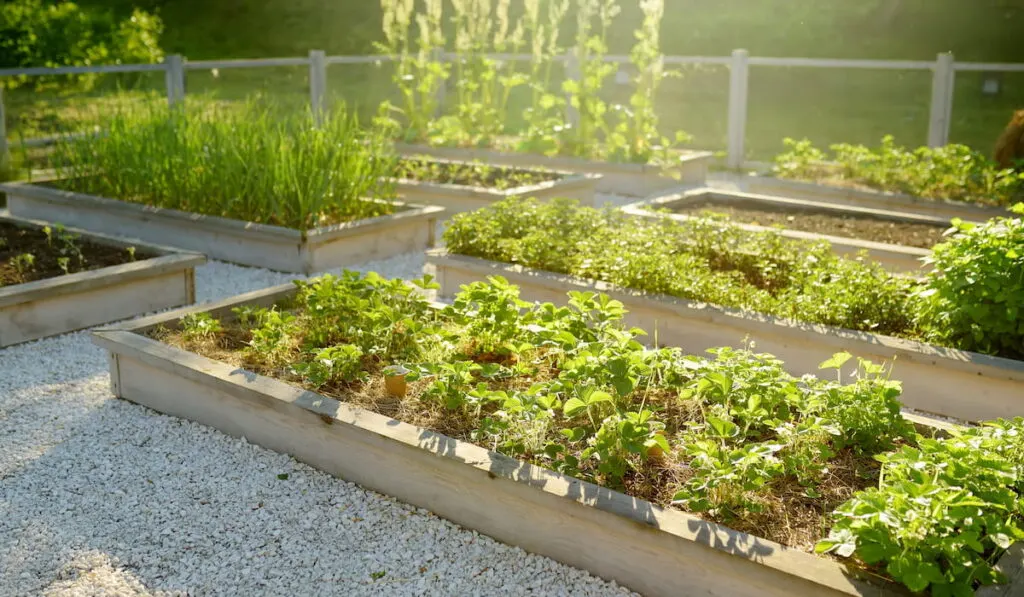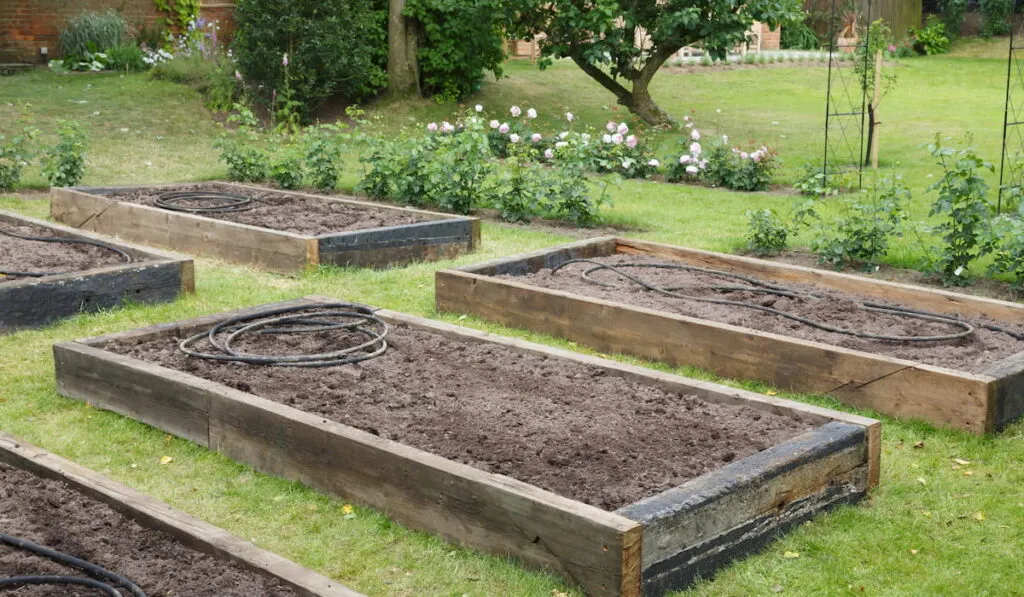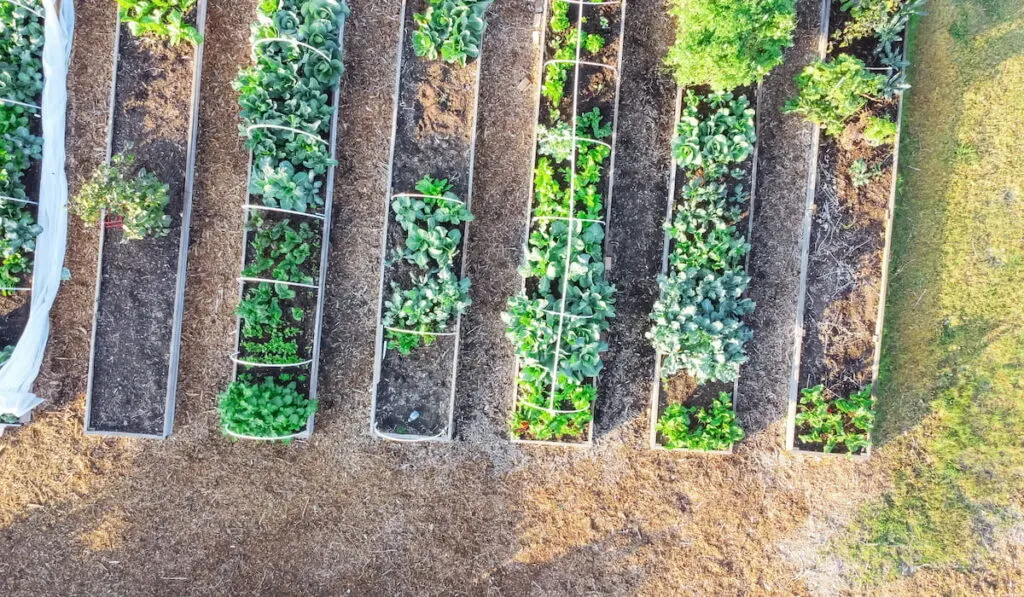Table of Contents
Is Bed Sizing Important?
The main aim of putting up a raised bed is to maximize your garden space and give easy access to all parts of the garden for maintenance and harvesting. It is, therefore, better to get it right the first time you construct the garden to avoid later regrets and desires for renovation.

Putting up raised beds requires some time and thought to figure out the optimal layout for production, efficiency, and flexibility for years to come.
What Size Should You Consider?
Raised gardens provide an easily accessible garden space filled with healthy soil that encourages plants to thrive. Every inch of growing space should be accessible from at least one side of the bed.
A width of four feet is the average for most gardeners to access at least half of the garden from one side.
With this width, there is never a need for stepping into the raised bed.
Depending on the available space and the demands of the garden, the length of the garden can vary from two to eight feet or even more.
Does Width Matter?
The width of the bed matters a lot, for you should provide accessibility and easy reach up to the middle of the garden from both sides of the bed, to reduce the need to step into the garden.
Therefore, when planning raised beds, the optimal width for a bed suitable for children to access is three feet wide, and four feet wide for adults.
For gardeners with restricted movement, a two-foot-wide bed for children and a three-foot-wide bed for adults would be appropriate.
Does Length Matter?
Though the bed length is not as critical as the width, having very long beds can be problematic to work on and walk about when gardening.
It should, however, be noted that the length is only limited by the available gardening space and the building materials used on the bed.
You should therefore be ready to incur a higher cost of materials when planning on putting up beds longer than twelve feet because the cost of lumber beyond this increases noticeably.
Does Depth Matter?
Depth is a critical factor to consider when putting up beds, especially if you want to plant crops that require deep soils for adequate root growth. The garden should be deep enough to hold adequate high-quality soil for optimal production.
The minimum depth needed for reliable growth is 10 inches. Vegetable gardens perform best with 12 to 18 inches of soil depth since vegetables need more room for root growth.
In some cases, these beds could be elevated off the ground with poles or blocks, best serving gardeners with restricted movement.
This is also a way to ensure the imported, higher-quality soil doesn’t mix with the poorer native soil. The bottoms must, however, be strong enough to handle the pressure exerted by the soil when wet, and still allow for efficient drainage.
In some instances, however, you can till the pre-existing soil below the raised garden bed if the raised bed has a depth less than the recommended 10 inches.
When dealing with a range of gardeners, it is a good practice to construct gardens with different heights. Children, need beds closer to the ground, and to accommodate wheelchair access, the beds should be at least 24 inches high.
On the other hand, a bed that is 36 inches off the ground level is the best and most accessible, as it helps avoid lots of bending over.

How to Choose the Best Size for Your Garden
There are three important factors to consider when sizing and putting up raised garden beds, namely;
- Materials used for the raised bed.
- The slope of the garden space.
- Accessibility for all gardeners.
Materials
Wood is the most popular material for constructing raised garden beds. Though not always accessible, 10–12-inch wide boards are the most suitable to attain the necessary depth for holding the soil.
On the contrary, 2-by-6 or by-8 inch boards are more accessible, and to attain the appropriate size, you will have to stack at least 2 of these timbers together.
When using wood, however, you should always avoid using treated wood because they contain chemicals that could eventually leach into the soil and end up contaminating the foods in the garden.
Choosing the Best Wood for Raised Beds
Though wood is the most popular and most recommended, many are concerned about the safety of the wood they use to frame the beds. CCA pressure-treated wood, for example, is known to leak arsenic into the soil and is no longer available in stores.
However, safely treated and untreated woods are available for gardening.
- Safely treated wood has chemicals that keep it from decaying. Although studies have proven that any chemical compounds that may leach out into the soil are far under the EPA’s acceptable levels, some gardeners remain cautious of the treated wood. If this is the case for you, it is recommendable to use polyethylene plastic to coat the inner surface of the bed walls.
- Untreated wood – cedar is the top choice for untreated wood brands because it is inherently rot-resistant and more durable, lasting approximately 10 – 15 years. Cedar is also popular because it has oils within, which makes it insect-resistant. The only disadvantage is that it is quite expensive. Depending on the wood, however, other untreated woods may decay quite rapidly. Much thicker widths of untreated woods should last longer than the regular-sized ones without requiring treatment.
Apart from the traditional lumber, there are other alternative materials for raised garden beds. Let’s look at them:
- Composite wood is a good option for your beds, made of both recycled wood fibers and plastic. It is durable and rot-resistant but can be quite pricey.
- Treated railroad ties can be used because they are easy to lay on the ground and have iron spikes driven in to hold them in place. They also do not pose any health risks because most of the creosote is already leached away.
- Pallets can also be a cheap source of garden bed materials, provided you know the source of the pallet. They are originally designed for shipping materials, and some may contain chemicals, such as methyl bromide, that may leach into your soil and affect the overall productivity of the garden. It is therefore good to verify that the pallet is safe before introducing it in your garden.
- Stone walls or concrete bricks and blocks can also be a good fit for your garden. Stones make interesting beds and give a rustic feel to your garden. Stones can, however, be pricey. Concrete on the other hand is good, but over time, it may increase the soil pH and you may need to amend the soil after some time.
Slope
The raised beds should ideally be flat, and this should be considered from the initial stages of the foundation. It is therefore good to install the raised beds with the shortest dimensions perpendicular to the slope, like stairs, to maximize the leveling of every garden bed.

Accessibility
Paths
The spaces between garden beds should be carefully considered. If possible, the garden layout should have one central path that stretches from one end to the other to provide room for gathering and central access to everyone.
Twelve-inch paths are the recommended minimum for raised beds to accommodate foot traffic. To ensure accessibility for all gardeners, paths of 30-36 inches work better.
Larger paths might also look plenty when laying out the foundations, but plants have a habit of encroaching on the paths, till at times, they may be impassible.
Orientation
The orientation of the raised beds does not always pose a problem, provided there is adequate spacing between the beds.
However, to avoid overshadowing and shading of smaller crops by the larger crops, it is good to lay out the beds in a north-south direction, to ensure maximum sunlight for every plant.
Irrigation
When planning to put up raised beds, it is good to consider having uniform bed spacing and layout to make irrigation easier.
Techniques like drip and overhead sprinklers are much more efficient when the beds are well organized, unlike hand watering where you will need to drag a hose throughout the garden.
Conclusion
To best determine the size of your desired garden bed, it is always good to first map out the appropriate area for your garden and take measurements to determine the available space.
An elaborate plan for your desired bed(s) should follow the steps above to give you the number of materials needed to construct your bed(s).
You may choose to go with one or two large beds, or it may be necessary to put up several raised beds with varying dimensions in a bid to get the most out of the gardening space.
Resources
- https://www.almanac.com/content/how-build-raised-garden-bed
- https://extension.uga.edu/publications/detail.html
- https://homeguides.sfgate.com/right-size-raised-beds-92835.html
- https://www.gardenista.com/posts/hardscaping-101-raised-garden-bed-how-to/
- https://www.hobbyfarms.com/tips-for-measuring-spacing-raised-garden-beds/
